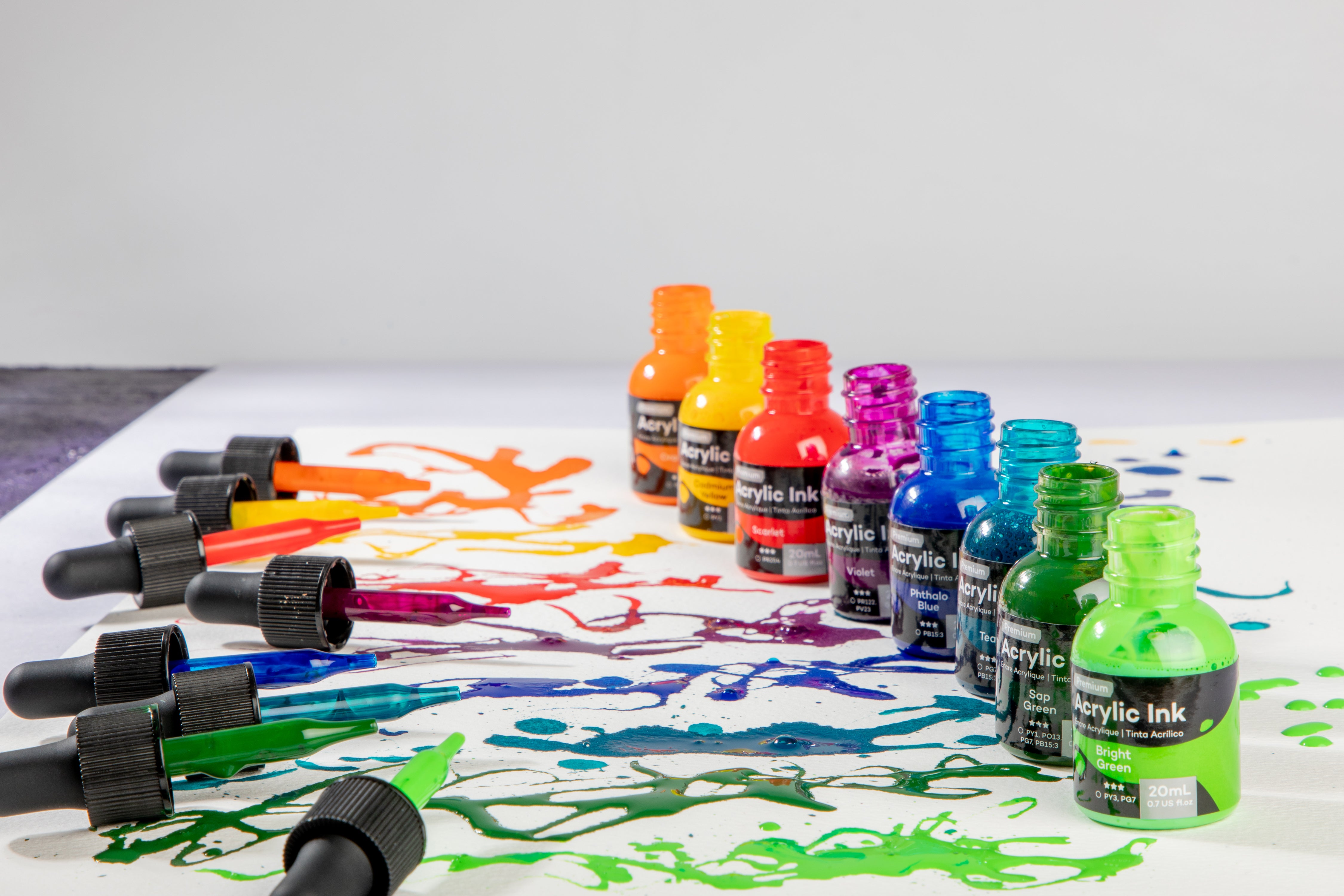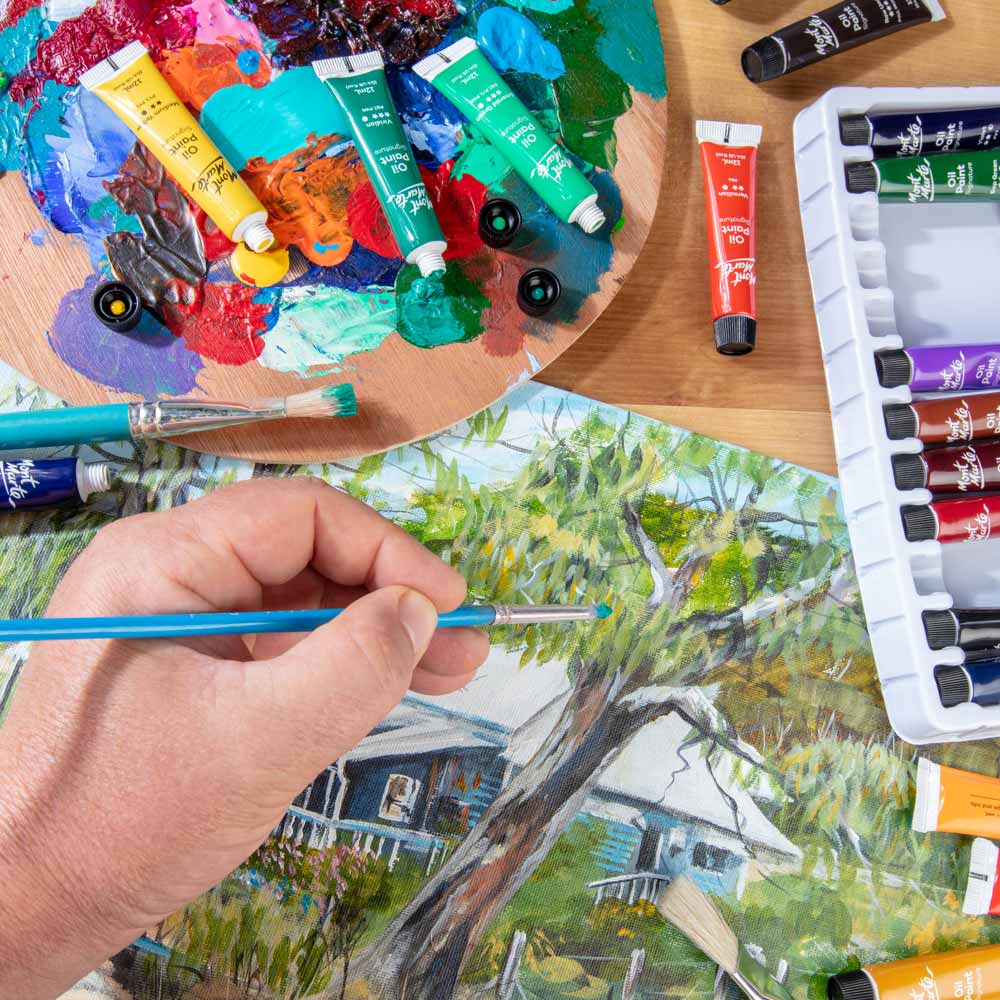Artist ink can be a great medium for all sorts of projects! From illustrating, hand lettering, and calligraphy, to multimedia, scrapbooking, and pouring projects, the possibilities are endless. So, if you’re intrigued by the fluid wonder of ink, why not find out more and read our answers to common ink questions?
1. What happens when you mix water and ink?
Mixing ink with water is an awesome way to create a watercolour effect. Simply add water to your acrylic or drawing inks until the desired opacity is achieved and brush it onto your page! As both our inks are water-based, they can both be used for this technique. Diluting ink can be a handy tool when illustrating to create dimension and play with highlights and shadows. Have a go at transforming your inks and see how they turn into watercolours by simply mixing in some water. You’ll often find this technique in traditional storybook illustrations, with pen and ink artwork accompanying the words on the page.

2. Can you use ink on canvas?
Yes, you can! However, acrylic inks will work much better than drawing inks. This is because acrylic inks are pigment-based, which helps them bind to the fabric of the canvas better. This isn’t to say it’s impossible to use drawing inks! As canvas is essentially a stretched fabric, your drawing inks are likely to bleed or spread when applied. However, if you prime your canvas with a textured gesso, it will help to seal the canvas, giving you better control over how your ink interacts with the surface.
3. Which Mont Marte ink is permanent?
Our acrylic inks dry permanently because they are pigment-based. This means if you spill water on them after your artwork has dried, the ink won’t bleed or spread as it is water resistant. On the other hand, our drawing inks are dye-based so they won’t be permanent when dry. If they get in contact with water, they may bleed or disperse on the page.

4. How to pour with ink
You can technically pour with either of our inks, as they are both great for creating fluid art. Our acrylic inks are great because they can be used with thinned acrylic paints to create varying effects. To try the ink pouring technique, simply mix a pouring medium with the ink to dilute it, then layer your chosen colours in a cup before pouring them onto a painting surface. If you want some inspiration for fluid art, check out our article, 15 acrylic pouring techniques. Try experimenting at home to see what kinds of effects you can create!
5. What are some popular ink art styles?
Ink string art – Use a foldable painting surface, such as paper, and soak a piece of string in ink. Pop the string on one half of your paper in a curvy, overlapping shape across your page, leaving the end of the string trailing off the page. Fold the other half of the paper over the string and press it down. While holding the paper down, grab the end of the string outside the borders of the page and pull it slowly so the string is removed from the paper sandwich. Open your paper up to reveal modern, abstract art with interesting dimensions!
Ink and watercolour drawings – Watercolour and ink are often used in combination to create art with gentle colour palettes. Think of classic illustrations such as Winnie the Pooh, with soft colouring and inked outlines. Watercolour can also be used to create free-form splashes of colour, with inked lines to add definition.
Pen and ink projects – Sketching with a monochromatic palette using ink and pens can be a great way to capture a subject. This popular art style typically has many lines and strokes to capture details, with techniques such as crosshatching or pointillism for shading. We have collected some amazing pen and ink drawings to inspire you to have a go at home.
6. Can you use ink in an airbrush?

Absolutely you can! Both our acrylic and drawing inks will work in an airbrush, however, the acrylic ink is easier to use. This is because our drawing inks are made with a shimmery finish, so to get the sparkle on the page you’ll have to use a double-action airbrush.
The key difference between single-action and double-action airbrushes is that double-action has the fluid cup on top of the airbrush, while single-action has the cup below. With single-action, the shimmer will sink to the bottom of the cup and won’t make it out of the airbrush and onto your work. With double-action, gravity will do the work for you and push the shimmer out!
Acrylic inks will work with both kinds of airbrushes. As with any airbrush project, make sure you thoroughly clean your machine after use to keep it in tip-top shape.
7. Are inks lightfast?
Pigment-based inks like our acrylic ink range, are typically more lightfast than dye-based inks. Pigment particles are bigger than dye particles, which helps them resist water when dry and stay more vibrant when exposed to light. It’s always a good idea to properly care for your ink works and store them out of direct sunlight and even in a frame if they’re on display!

8. Can any ink go in a fountain pen?
Dye-based inks such as our drawing inks take the cake when it comes to using fountain pens. Because they have smaller particles, they flow thinner and are unlikely to clog up the nib during use. Acrylic inks, on the other hand, have large pigment particles that are more likely to interrupt the ink flow through the fountain pen and require flushing regularly to clear jams.
When you use drawing ink, we always recommend maintaining and cleaning your fountain pen frequently to keep it in top form.
9. How to use a dip pen with inks
When holding your dip pen, simply grip it like a pencil. Dip the pen in your ink of choice, until the small hole in the nib is covered. This hole will store a small reservoir of ink, so you have to dip less while using the pen! If you get too much ink on your nib and it’s dripping, just gently tap or sweep it against the edge of the pot to release some of the fluid. It’s best not to have a dripping pen as it will create drops of ink as you bring the pen down to the paper.
Holding the pen at a 45° angle from your art surface, begin to write or draw gently. There should be no need to apply excess pressure as the ink should flow freely with a light touch. Each dip of ink should last around 2-3 sentences or an equivalent amount of drawing, but finer nibs will require more frequent dipping as their reservoir is smaller.
Both our drawing and acrylic inks can be used with a dip pen to create fine lines, hand lettering, and illustrations. Either ink will work well, so make your choice based on the colour range and finish. Remember, our drawing inks dry to be shimmery!

10. Best surfaces for ink?
Ink works best on surfaces that react well to thin, fluid mediums. Paper and board work well with our drawing inks and acrylic inks, with the latter applying well to canvas too. Acrylic inks also work with some plastics, so try experimenting at home to find out which art bases work best for you!
Now you’ve learned a little more about our artist ink, we hope you feel ready to explore and experiment at home to see them in action.
We’d love to have inspired you to try a new project, go back to an old one, or even just think about your favourite kind of ink art styles.
If you do get creating, #montmarteart or tag us @montmarteart on Instagram or Facebook. We’re excited to see what you come up with!
Looking for more? Check out our Projects and How-to’s for some inspiration. If you need any of the supplies mentioned in this blog, jump online to check out our range of artist ink products.





































